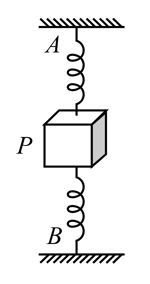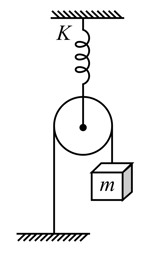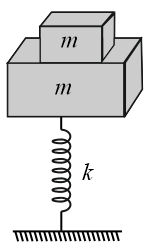Three masses , and are suspended at the end of a spring as shown and are in equilibrium. When the mass is removed, the system oscillates with a period of , and when the mass is also removed, it will oscillate with a period of



Important Questions on Linear And Angular Simple Harmonic Motion
Four massless springs whose force constants are , , and , respectively, are attached to a mass kept on a frictionless plane (as shown in the figure). If the mass is displaced in the horizontal direction, then the frequency of oscillation of the system is

Two identical springs are attached to a small block . The other ends of the springs are fixed at and . When is in equilibrium the extension of top spring is and extension of bottom spring is . The period of small vertical oscillations of about its equilibrium position is (use ).

The below figure shows a system consisting of a massless pulley, a spring of force constant and a block of mass . If the block is slightly displaced vertically downward from its equilibrium position and then released, the period of its vertical oscillation is

A block of mass is at rest on another block of the same mass as shown in the figure. Lower block is attached to a spring, the maximum amplitude of motion so that both the block will remain in contact is:

The springs shown in the figure are all up stretched in the beginning when a man starts pulling the block. The man exerts a constant force on the block.

A block is executing simple harmonic motion of amplitude on a smooth horizontal surface under the restoring force of a spring of spring constant . A block of mass is gently placed on it at the instant it passes through the mean position. Assuming that the two blocks move together, then

